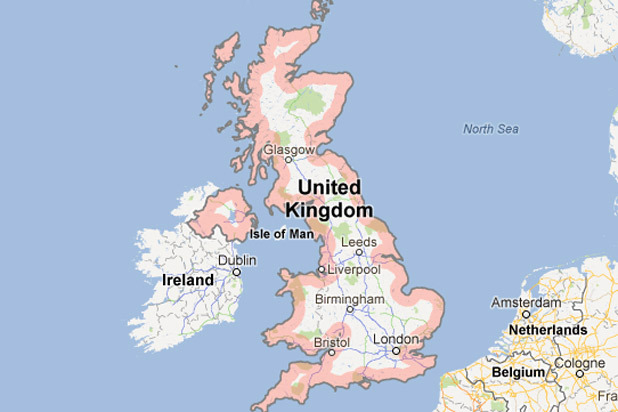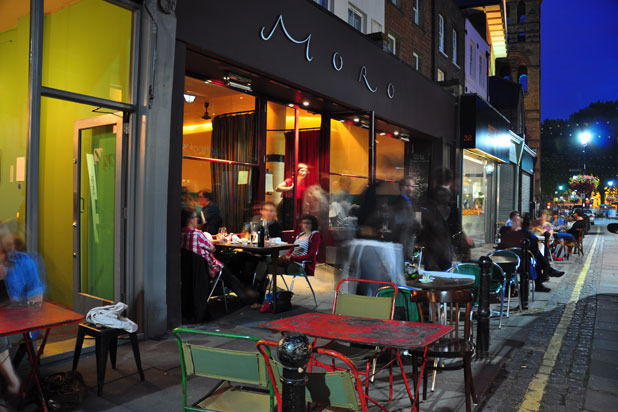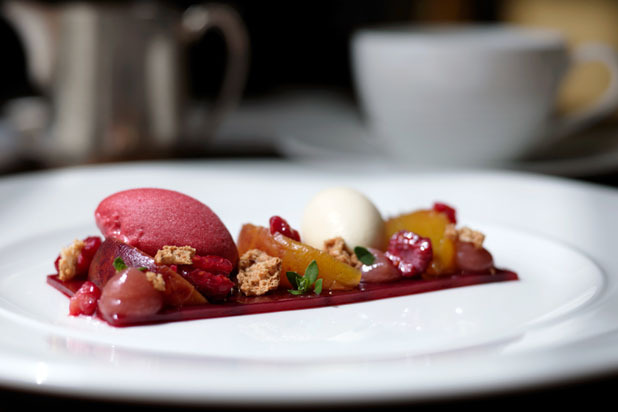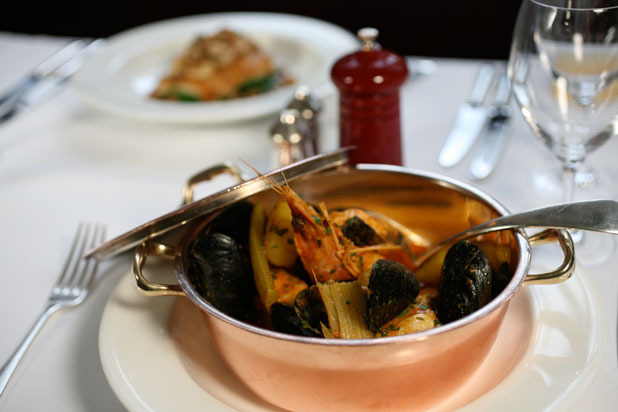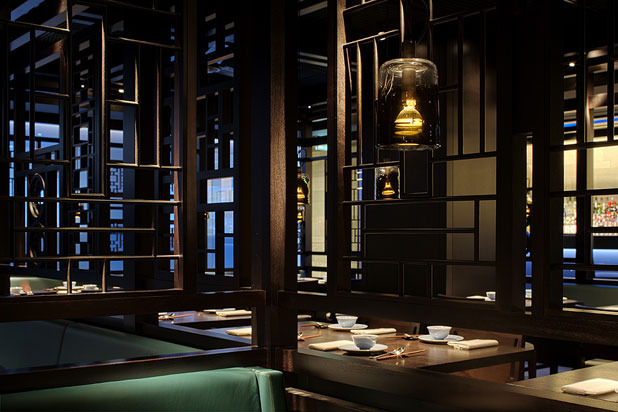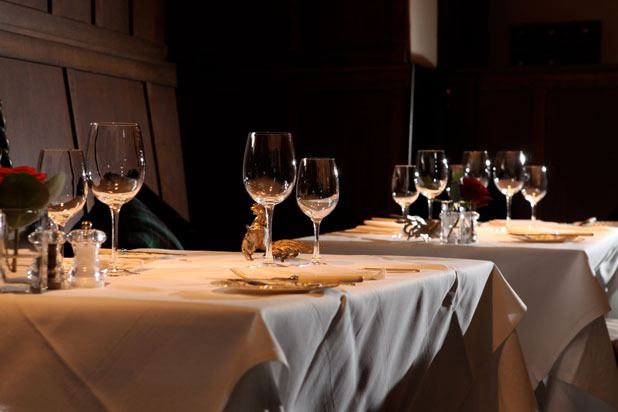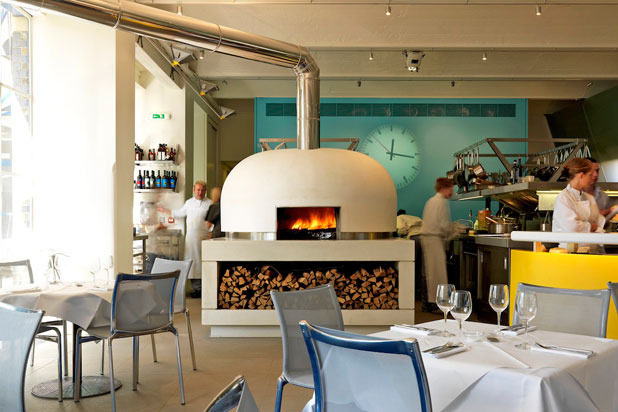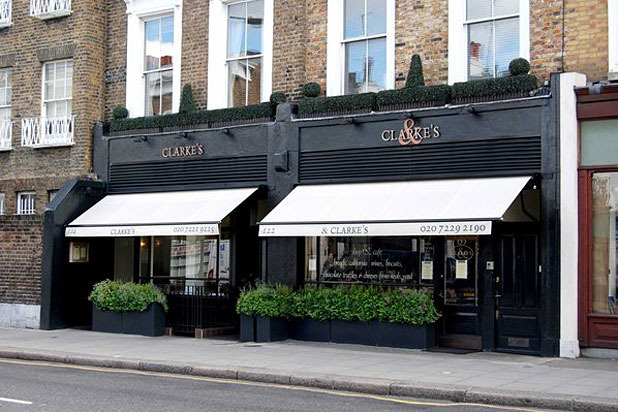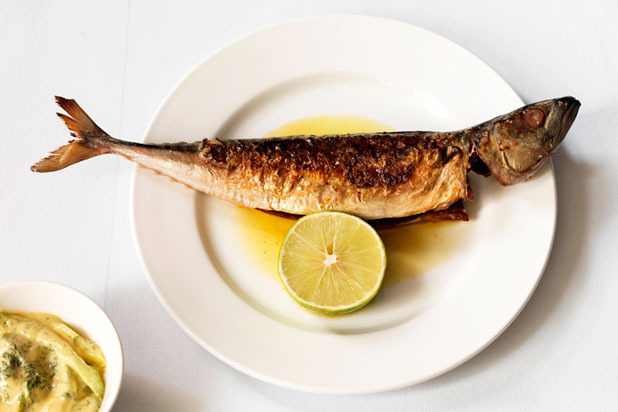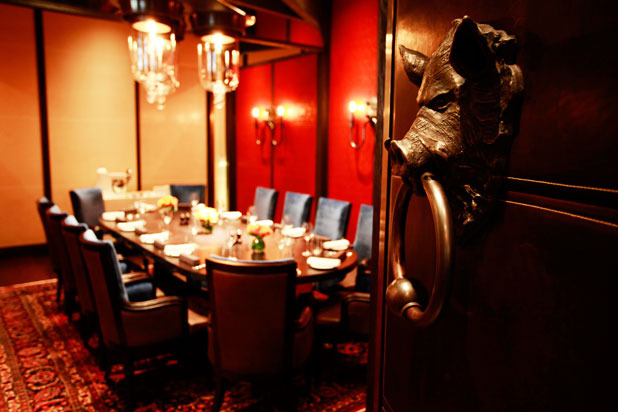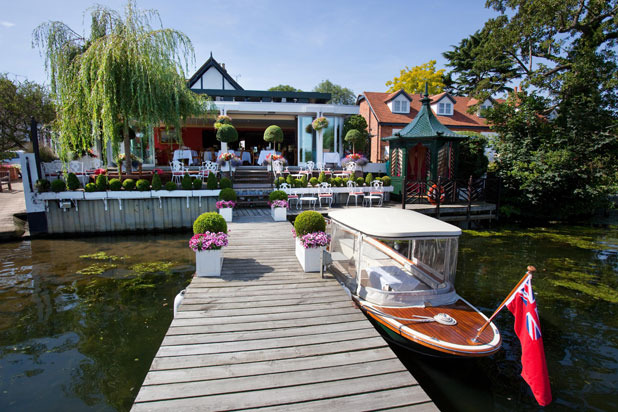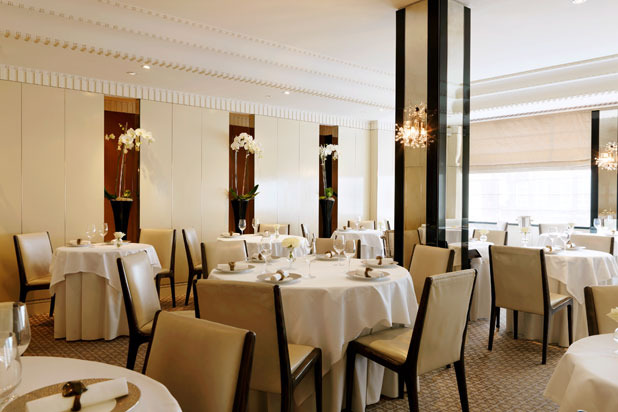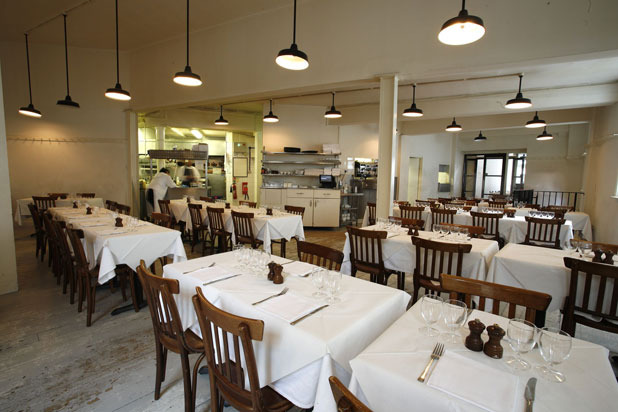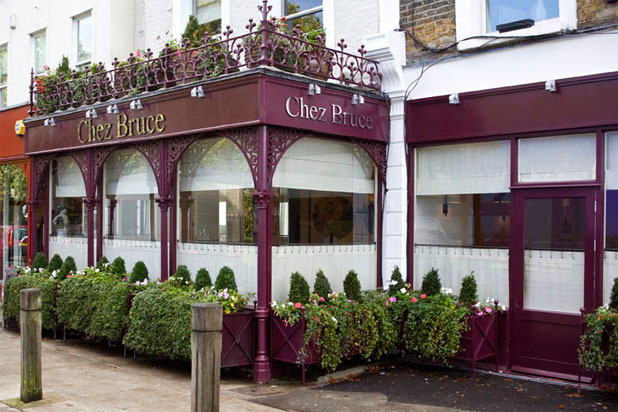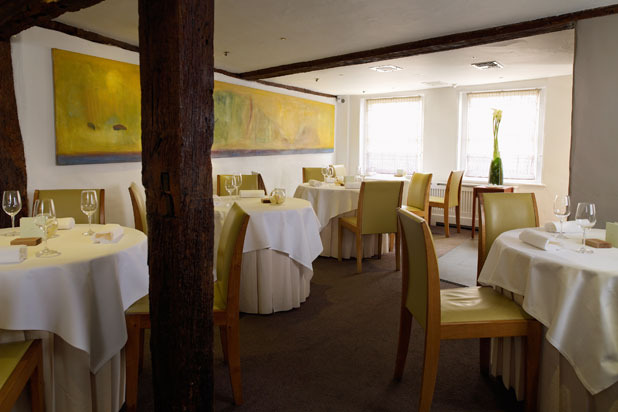25 Best Restaurants In England And Scotland
Each week this fall, The Daily Meal will highlight the best restaurants in various regions in Europe, culminating with the debut of our first list of the 101 Best Restaurants in Europe in December. The Daily Meal presents the 25 Best Restaurants in England and Scotland.
25. Moro (London)
Opened by husband-and-wife veterans of the excellent River Cafe, Moro improvises on Spanish and Middle Eastern themes, but with a sense of originality that gives the place very much its own culinary identity. A whole repertoire of tapas and their Middle Eastern equivalent, mezze, are offered at the bar (olives, fried spiced chickpeas, baba ganoush, charcoal grilled chorizo, pimiento de padrón, etc.), while at the tables, fare might include pumpkin-stuffed fatayer (turnover), wood-roasted pork with fried peppers and romesco, bream baked with potatoes, anís, and lemon-thyme oil, and yogurt cake with pistachios and pomegranate. The wine list is strong on sherries, and full of good Spanish vintages at fair prices.
24. Maze (London)
David Rockwell's design plays on the moniker of Gordon Ramsay's Maze. The Asian-inspired French fare includes tasting plates, à la carte options, and a seven-course chef's menu. This might include marinated yellow fin tuna with compressed apple, coriander, horseradish, and ponzu; rabbit, smoked duck, and foie gras terrine with peaches, sauternes gel, and bitter almond; and lobster, tiger prawn, and salmon dumplings in lemongrass broth.
23. J. Sheekey (London)
A theater-district standby for generations, now in a smart new incarnation. A treasure trove of mostly North Atlantic seafood — oysters, potted shrimps, Atlantic prawns, lemon sole, haddock (fried, with chips and mushy peas — upscale fish 'n' chips), old-fashioned fish pie, and more awaits at J. Sheekey. Meat and (in season) wild game dishes are also available for those who aren't piscatorially inclined — but why would you come here if not to enjoy the first-rate seafood?
22. Hakkasan Mayfair (London)
Outposts of this high-end Chinese establishment (created by the founder of the low-end Wagamama Japanese noodle chain) — there are Hakkasans in New York City, Las Vegas, Miami, San Francisco, Abu Dhabi, Dubai, and Mumbai, plus a second London location — have been criticized for their precipitous prices and the uneven quality of their cooking. The original, though — while indeed pricey — maintains high culinary standards in a sleek, buzzy, multi-million-dollar interior. From jewel-like dim sum (scallop shumai, Chinese chive dumplings) to bright seafood (roasted silver cod with champagne and honey), from unexpectedly good faux-poultry (tofu "chicken" with sugar snaps) to extravagances like Peking duck with Royal Beluga caviar.
21. The Boat House (Edinburgh, Scotland)
Along the River Forth, husband-and-wife team Paul and Suzanne Steward serve a seasonally changing menu of fish and bistro fare made with locally sourced ingredients. The Boat House's fish menu changes daily and the bistro menu changes every three months. Dishes may include hot smoked salmon and mackerel fishcakes on a creamed leek and chorizo sauce and pan-fried scallops on a salad of sautéed potatoes, tomato, and mixed leaves, drizzled with white truffle-scented olive oil.
20. 21212 (Edinburgh, Scotland)
A mere eight months after its opening, 21212 was awarded a Michelin star. Set in a restored four-story Georgian townhouse, the 38-seat French restaurant has an open kitchen, drawing room, and private dining room, plus four adjacent bedrooms. Chef Paul Kitching leads a team of seven chefs who prepare set lunch and dinner menus. The five-course dinner includes a choice of starters like creamy Gruyère risotto with six types of mushrooms, a choice of mains like chicken curry with pineapple and artichokes, and desserts like layered spring trifle with blueberries, Granny Smith purée, pecan, honeycomb praline, shortbread, and sliced bananas.
19. The Modern Pantry (London)
Comprised of a bright and airy café, 60-seat dining room, pantry, and foundry room that overlook St. John's Square, The Modern Pantry was founded by chef Anna Hansen. Rob McLeary heads the kitchen, which crafts home-style fare like kimchi-marinated roast lamb rump accompanied by goat's curd, samphire, smoked almond, and beetroot salad with smoked anchovy dressing; and confit Barbary duck leg with saffron and toasted poppy seed spatzle with a roast tomato, fennel, and dandelion salad, accompanied by roasted red pepper and coriander salsa.
18. Two Fat Ladies at the Buttery (Glasgow, Scotland)
Despite its name, the kitchen at Two Fat Ladies at the Buttery, one of a trio of Two Fat Ladies restaurants, is run by a man, chef Stephen Johnson. The restaurant features oak and mahogany paneling, stained glass, and a marble bar, and its name is a reference to its street number, 88 — "two fat ladies" is a nickname for the number when called out in bingo games (the restaurant is not related to the once popular TV show Two Fat Ladies, starring Clarissa Dickson Wright and the late Jennifer Paterson). The menu includes Scotch beef with wild mushroom duxelle crouton and tarragon jus; king prawn brochette with salmon and red mullet served with roast vegetable couscous and tzatziki dressing; iced Belgian chocolate parfait with toffee vodka sauce and amaretti macaroon; and sabayon-glazed citrus fruits with a basket of strawberry and elderflower sorbet.
17. St. John Bread and Wine (London)
St. John Bread and Wine, an outpost of St. John Bar and Restaurant,opened across from Spitalfields Market in May 2003 .Smaller than its progenitor, it offers breakfasts including porridge and prunes and Old Spot bacon sandwiches and an evening menu of seasonal nose-to-tail fare with specialties like parsnip soup, smoked cod roe with potato cakes and duck eggs, chicken and leek pie for two, and Eccles cake with Lancashire cheese.
16. The Three Chimneys (Isle of Skye, Scotland)
For three decades, Eddie and Shirley Spear have been serving Scottish food and hospitality at The Three Chimneys on the shore of Loch Dunvegan in the remote northwest corner of Skye, an island off the west coast of Scotland. Spread across three small dining areas on the ground floor of a 120-year-old crofter's cottage, the restaurant serves lunch from mid-March to mid-October; dinner is served nightly all year long. The set-menu-only restaurant offers a three-course dinner menu and a seven-course Skye Showcase menu, which can be served at one of the wooden tables topped with crisp white linens or at the kitchen table. Courses include Andy Race smoked haddie and ham terrine with Brunigill Farm quail egg, syboes (spring onions), orange, and nasturtium; cannelloni of crowdie (Scottish cream cheese), Totaig kale, and pine kernels with asparagus and mulled Cheddar; pan-fried Gigha halibut and Sconser scallop with Anna potatoes, rhubarb, cauliflower, and vanilla velouté; and iced toddy parfait with pink grapefruit and aniseed brittle.
15. The River Cafe (London)
Someone once called this "the best Italian restaurant in Europe" — Italy included. That may be an exaggeration, but the refreshingly simple, imaginative but authentic Italian food that has been produced at The River Cafe by Ruth Rogers and (until her untimely death in 2010) Rose Gray since the late 1980s. The noted British architect Sir Richard Rogers — Ruth's husband — has given the place a bright, almost sparkling energy (the room-length counter separating the kitchen from the dining room and the big wood-burning oven in one corner help). Staples on the menu include char-grilled squid with chile flakes and rocket (arugula), and seared Scottish scallops with various accompaniments — and of course the legendary Chocolate Nemesis cake. Among autumnal offerings might be tagliatelle with "first of the season wet walnut sauce" and herb-stuffed whole grouse on bruschetta.
14. Clarke’s (London)
Because she helped run some top Los Angeles restaurants for some years back in the 1980s, it was perhaps inevitable that when Sally Clarke returned to England and opened her eponymous restaurant, 28 years ago, she would be accused of having brought "California cuisine" to London. In fact what she brought was a then-rare concern for seasonality and freshness, as well as the radical notion of offering only a single fixed-price menu in the evenings (à la Chez Panisse). There is now a choice of dishes at night (as there always was for lunch), but the seasonality and freshness are still in place at Clarke's. Recent choices included chilled tomato, celery, and basil broth with white beans; grilled spatchcocked quail with cracked wheat and muscat grapes; breast of corn-fed chicken with sage, girolles, and leeks; and baked peach and blueberry pancake with vanilla ice cream.
13. Anstruther Fish Bar and Restaurant (Fife, Scotland)
As its name suggests, the menu at Anstruther Fish Bar centers on the sea, and their specialty is fish and chips. Whether you order the batter-dipped haddock and crispy chips to go or eat them in the 52-seat nautical-themed dining room overlooking the Firth of Forth, it's delicious — everything this classic treat should be. The Anstruther family has been in the fishing industry since the 1600s, and the present-day Anstruther shows films of family fishing trips — from the 1950s to present day, aboard the trawler MFV Argonaut, — in the dining room and takeout area. Robert Smith, his wife, and their three sons can all be seen working at the chippie shop.
12. Quo Vadis (London)
Jeremy Lee has long been one of the best no-nonsense, seasonally aware cooks in London, but in his berth at the Blueprint Café atop the city's Design Museum, he never got the attention he deserved. Now he's in the middle of Soho, at the old-line (but newly revivified) Quo Vadis. His wonderfully British menu ranges from (at this time of year) smoked eel and horseradish sandwich and crab with mayonnaise to whole mackerel with pickled gooseberries and "grouse & co". The room is pretty, the cooking is just right, and the wines are well-chosen.
11. Le Gavroche (London)
Since 1967, Le Gavroche has been a trail-blazer, bringing French cuisine of the highest quality to the capital and training scores of subsequently prominent chefs. Michel Roux Jr. has carried on the Roux family tradition since 1991. The menu includes marinated salmon with lemon and vodka jelly; black pudding, crumbed egg, crackling asparagus salad, and spicy tomato chutney; and crispy pastry with raspberries and praline chocolate.
10. Dinner by Heston Blumenthal (London)
Having given Britain some of the most scientifically advanced cooking in the world at The Fat Duck, Heston Blumenthal next embarked on a quest to give them some of the most historical. The conceit of Dinner by Heston Blumenthal (and yes, to answer the inevitable question, it is also open for lunch) is to reproduce recipes from his country's surprisingly rich culinary past. The oldest example on the current menu is Rice and Flesh (rice with saffron, red wine, and calf's tail, from c. 1390). The most famous dish is Meat Fruit (c. 1500), a chicken liver parfait coated with, and resembling, mandarin orange. Spiced pigeon with ale and artichokes (c. 1780), roast sea bass with leaf chicory and cockle ketchup (c. 1830), and a chamomile- and orange blossom-scented strawberry tart (c. 1591) are among the other offerings. The nice thing about all this food is that it's very tasty and doesn't seem "historical" at all; it's a testament to the longevity of good cooking.
9. The Waterside Inn (Bray, Berkshire)
Founded by brothers Michel and Albert Roux, of Le Gavroche, also on The Daily Meal's list of Top 35 Restaurants in the U.K. and Ireland, The Waterside Inn was transformed from an English pub to a bucolic gastronomic destination on the banks of the Thames in Bray. Alain Roux's seasonal à la carte and three-course set menus — full of such delights as chestnut and champagne velouté with partridge and foie gras, pan-fried scallops on a bed of lime-scented carrot mousseline, medallion of veal with mustard crust served with breast of veal braised with ceps and Swiss chard, and warm golden plum soufflé — have earned him three Michelin stars.
8. Nobu London (London)
The first European venture for Japanese chef Nobu Matsuhisa, the sleek and sophisticated Nobu London is located in The Metropolitan Hotel. Matsuhisa's Japanese cuisine, infused with Latin American influences, has earned the restaurant a Michelin star. The menu includes Wagyu beef and foie gras gyoza with spicy ponzu sauce; black cod on butter lettuce; and a multi-course omakase menu.
7. The Wolseley (London)
The flagship of the burgeoning restaurant empire of Jeremy King and Chris Corbin (who had earlier brought The Ivy, The Caprice, J. Sheekey, and other classic London restaurants back to life), The Wolseley occupies a light-filled, high-ceilinged space on Piccadilly that was once home to the short-lived Wolseley Car Company and then to Barclays Bank. The feeling of the place, like the menu, is French brasserie with a touch of Viennese coffeehouse. There are splendid oysters, coq au vin, choucroute à l'Alsacienne, wienerschnitzel, and (because this is England) kedgeree, among many other things. Breakfast is a delight here (Gruyère omelette, crispy bacon roll with fried egg, homemade müesli), as is afternoon tea.
6. Restaurant Gordon Ramsay (London)
Since 1998, Restaurant Gordon Ramsay has served impeccable cuisine in an intimate 45-seat dining room designed by David Collins. Ramsay's first restaurant, this establishment was awarded three Michelin stars in 2001, and head chef Clare Smyth is the only female chef in the U.K. to hold this honor. The three-course lunch menu includes smoked potato and poached hen's egg ravioli with bok choi, roast chicken jus, and leek velouté; Cornish pollock with chorizo couscous, baby squid, artichoke, and spiced tomato jus; and banana parfait served with a peanut butter mousse and bitter chocolate sandwich with caramelized bananas.
5. St. John Bar & Restaurant (London)
Chef Fergus Henderson's St. John holdings are slowly growing (St. John Bread & Wine, a St. John hotel with restaurant attached, and a freestanding bakery have been added in recent years), but the original establishment — which Henderson and his business partner, Trevor Gulliver, now refer to as "The Mothership" — is still going strong. Minimalist in style, with a menu heavy on pork products and organ meats (crispy pig skin with radishes and watercress, rabbit offal and swedes [rutabagas], lamb sweetbreads with carrots and bacon) but offering lighter fare as well (native oysters, sole with tartare sauce), St. John remains a paradise for anyone interested in no-frills, U.K.-sourced, superbly cooked English fare.
4. The Witchery (Edinburgh, Scotland)
Set in a 16th-century merchant's house, The Witchery serves Scottish seafood, its signature Angus steak tartare, and that most definitive of Scottish dishes, haggis. Lunch, dinner, and pre- and post-theater suppers are available. The sumptuously appointed baroque-style dining room includes ancient oak paneling and heraldic painted ceilings, tapestries, and antique candlesticks. Guests who stay at The Witchery, which is also a small hotel, are treated to candlelit breakfasts.
3. Chez Bruce (London)
Bruce Poole and Nigel Platts-Martin opened Chez Bruce in 1995 on the site of Harvey's, where Marco Pierre White first made his name. Poole has collaborated with head chef Matt Christmas to create the menu of modern fare based on French and Mediterranean cuisine. You won't find fussy food, foams, or gels on the menu; instead it is filled with charcuterie, slow-cooked braises, offal, warm and cold salads, cheese boards, and classic desserts like hot chocolate pudding with praline parfait; Paris-Brest with poached pear and butterscotch sauce; and roasted Provençal figs with iced Marsala parfait and warm almond financier served in an equally relaxed setting.
2. The Fat Duck (Bray, Berkshire)
Heston Blumenthal's temple of so-called molecular gastronomy, The Fat Duck, is lots of fun, a kind of haute-cuisine theme park where the food is delicious and the unorthodox presentations will make you smile. Mini-cocktails (vodka and lime sour, gin and tonic, Campari soda) are "poached" with liquid nitrogen. "Sound of the Sea," a fantasy involving five kinds of shellfish, several varieties of seaweed, "sand" based on toasted panko breadcrumbs and maltodextrin, and assorted Japanese flavorings (mirin, tamari, and kombu, among others), is served with an iPod playing, well, sounds of the sea. A new dish on the menu, Mad Hatter's Tea Party, involves a tea bag of edible gold leaf filled with gelatinized bouillon and shaped like the Mad Hatter's pocket watch, along with a "caterpillar" made of ox tongue terrine and a mock turtle egg made of puréed vegetables. The charm of food like this is that it's presented without pretension, as if it were a series of benevolent magic tricks designed not to intimidate but to amuse. (Warning, though: This divertissement takes about four hours and costs $290 per person, without wine or tip.)
1. Alain Ducasse at The Dorchester (London)
One of a trio of Alain Ducasse's restaurants to be awarded three Michelin stars, Alain Ducasse at The Dorchester serves contemporary French cuisine in a bright and airy space with blonde wood walls and crisp white linen-topped tables. Executive chef Jocelyn Herland uses seasonal produce from England and France to create the à la carte menu and three-course set menus. The menu includes a heritage tomato tart with fresh herb condiment; "sauté gourmand" of lobster and truffled chicken quenelles; baked halibut, toasted hazelnuts, peas, and Saint George's mushrooms; and Anjou pigeon "à la broche" with tender potatoes and sauce Choron.
